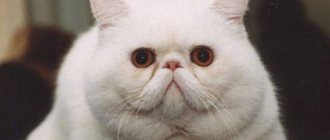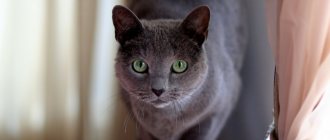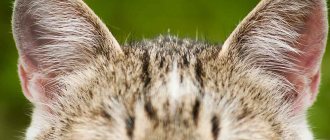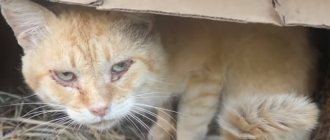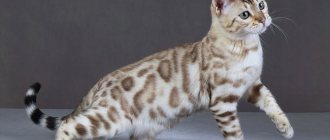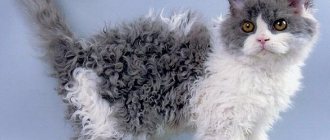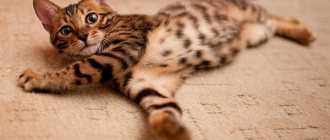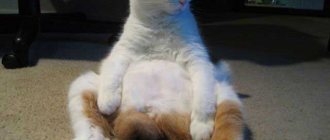Laperm: description of the breed, keeping a purebred cat and features of its choice (130 photos)
Domestic cats come in different breeds, long-haired and short-haired, but pets with curly hair are especially endearing. Such animals have an attractive appearance and are representatives of one of the most unique breeds with a short, but quite interesting and non-trivial history.
Carefully studying the photo of the laperm cat, you can see that these human favorites are distinguished not only by their original appearance, but also by their varied colors.
Friendly and curious pets are quite active and become extremely attached to their owners, although street cats are considered their ancestors.
Origin of the breed history of Laperm cats
The main feature of laperm cats is their curly hair of medium or increased length, which comes in different colors.
The world community owes the appearance of the breed to an ordinary English cat lover, who left a hairless kitten from the next litter of her pet.
Over time, the kitten became covered with curly and curly fur, which became one of the characteristic features of this amazing breed.
General characteristics and features of animals
The description of the Laperm breed includes generally accepted standards that allow you to visually distinguish cats of this breed from other felines.
The general characteristic is a rather specific appearance and an open, simple character, but such pets require special care.
Appearance
Before finding out how much a Laperm costs, you must be sure to familiarize yourself with the breed standards.
This will allow you to get to know your future pets better and understand their characteristics, which will allow you to take a balanced approach to choosing a pet for yourself or the whole family. Representatives of this breed are distinguished by the following parameters:
- slender and fairly strong body with average size;
- curly fur represents well-groomed curls;
- curls of wool curl into rings and spirals or ears to a tail;
- the fur is silky and soft to the touch, it flutters in the wind;
- The undercoat of leks is not thick, the coat often lies tightly to the body;
- the head has a wedge-shaped, regular shape with high cheekbones;
- On the round muzzle, the snub nose especially stands out;
- The ears of such cats are quite large and widely spaced;
- The average weight of pets can vary between 2-4 kg.
The peculiarities of the breed include the lack of a standard for the color palette of animals that can be colored.
Such pets grow up for quite a long time and remain playful kittens up to 2 years of age; kittens can lose their fur to the point of baldness, but then it grows back and becomes even thicker.
Pet Personality
Due to their simple origins, such pets have a fairly simple and friendly character and get along well with adults and children.
Breed standard
According to WCF and FCA, representatives of the LaPerm breed must meet the following canons:
Head
- wedge-shaped with neat rounded features;
- the ears are large, set wide, set high, deep;
- Long-haired cats may have tufts at the tips of their ears;
- forehead neat, flat;
- the bridge of the nose is quite thin, the nose is small, the color matches the color of the coat;
- the eyes are almond-shaped, large, expressive, any color is acceptable, the gaze is open, attentive, lively;
- lips are neat, whisker pads are rounded and dense;
- the chin is wide and strong; the profile is straight.
Torso
- medium build, delicate constitution, somewhat refined bone structure;
- the line of the back is slightly raised towards the tail;
- the main thing is that all items must be proportional.
Forelegs
- neat, sophisticated, may be slightly shorter than the rear ones;
- The paws are gathered in a bun, rounded, the toes are neat and small.
Hind limbs
- quite muscular, but at the same time graceful, due to the fact that the length is longer than the front ones, it seems that the cat is constantly rising, walking on outstretched paws;
- The fingers, as on the front ones, are small and neat, tightly tucked.
Wool
she is given special attention; in long-haired cats it can be frizzy to varying degrees - from wavy to curly; looks somewhat carelessly disheveled; light, soft and fluffy, also loose, soft; it is easy to reach the skin through it; there may be a curly collar, tassels on the ears; short-haired individuals have slightly coarser hair, but the main characteristics are similar; on the tail the hair curls especially intensely and sticks out; on the back it can part and hang down on the sides of the spine; scythes twisted, long, flexible
Dimensions
- cats are noticeably larger than cats;
- the weight of males is 4 - 5 kg, females - 3 - 4 kg.
And here you will find the schedule of WCF cat shows for 2020.
Description
The wonderful fur of this curly-haired beauty is twisted in spirals in the direction from head to tail.
Silky, soft fur curls unevenly over the body:
- chaotic curls - on the back, lower part of the body, on the sides;
- tight rings - on the withers, behind the ears, on the chest.
LaPerm cats are a medium-sized breed.
Breed standard:
- head – smooth, rounded contours smooth out the wedge-shaped shape of the skull;
- muzzle – wide, round, with a snub nose, with convex pads for a flexible, long mustache;
- ears - set wide, medium in size, rounded, curls grow in the middle of the ears, as well as tassels at their tips;
- eyes – slanting, large, expressive, elongated, eye color does not depend on coat color;
- body – lean, muscular, strong, hips – above the shoulder line, raised;
- paws – compact, graceful, proportional, the forelimbs visually appear shorter;
- tail – long, covered with long or short curly hair;
- weight – adult cats weigh 4-5 kg, males – 2-3 kg more.
Thick curls at the withers look like a rich astrakhan collar. At the same time, the fur does not fit tightly to the body; if you blow on it, it easily moves apart.
The eye color of Laperms can be yellow, brown, emerald, blue, and some individuals have different eyes.
The nuances of choosing a kitten and its cost
There are few nurseries where this breed is professionally bred, but it is quite possible to buy a Laperm kitten. It is recommended to purchase kittens after they reach four months of age. Only after this time have passed, many of them become overgrown and the signs of a real breed can be seen. Of course, there are cats that are curly from birth, but this is not often observed. They also “go naked” after birth, but are covered with curls by the age of two months.
Please note: all the fur of these babies should already be in small curls. Check that the necessary vaccinations were given in a specialized clinic and are included and dated in the veterinary passport
Find out from the breeder about the cat's habits, play and chat with him. A purebred representative of a rare breed will cost you a lot. Make sure the contract stipulates, for example:
- mandatory castration/sterilization;
- participation in exhibitions is indicated.
How much does it cost and what kitten to choose?
A Laperm kitten is quite expensive, since the breed has only recently gained worldwide popularity. Kittens may be born hairless, with curly hair or straight hair. Hairless kittens acquire hair by at least two months. Those born with curls shed in the first months, but then the fur grows even thicker than it was.
But kittens with straight hair will remain without a wavy coat. In order to know what kind of fur an adult animal will have, you need to choose a kitten 4-6 months old. When selecting, breeders blow on the wool to see how it separates and evaluate its condition.
Due to the lack of undercoat, the breed is considered hypoallergenic, but it is still worth spending a couple of days with your pet in advance to make sure there is no allergy to wool. On average, the price for a kitten is from $500 for some and up to $4,500 for other breeders, it depends on the pedigree of the mother, color, quality of cover and gender.
Laperm - Curly cats: description of the breed - Details of care + Video and Photo
Fluffy cats with short or long, but always curly or curly hair are cats of the LaPerm breed (sometimes written as La-Perm). Appearing as a result of a natural mutation, these cats can have absolutely any color, they are friendly and calm, which seems to have won the love of many. Below you will find a short description of Laperm cats with photos, history of appearance and other information.
1982, a small Dallas farm in Oregon, spouses Linda and Richard Koel breed cats on their farm. When in the next litter of their outbred cat, one of the six kittens was born too small and hairless, the owners were sure that he would die. But the kitten survived, became covered with beautiful, curly fur and became the basis for the creation of a new breed of cats - LaPerm (from the French word for “perm”).
Description of the Laperm breed
Cats of this breed have a small and very graceful body, their hind legs are slightly longer than their front legs, the tail is proportional to the body and is plumed. Their head is wedge-shaped, crowned with widely spaced ears of medium or large size (which is also their characteristic feature).
Often, long-haired individuals may have tufts on the tips of their ears. Any color is allowed, the length of the coat is short and long. The color of the eyes also depends on the color: from copper to blue-turquoise, heterochromia (different eye colors) is found. Sometimes individuals develop a woolen collar, which does not depend in any way on the sex or length of the coat.
Disadvantages include possible bald spots in the coat, brindle color, squint, short legs and powerful body, straight fur, etc.
Character
Laperm cats have an easy-going character and get along well with people. They are patient, love to play, and have absolutely no anger, which is great for families with children. These curly cats are very attached to their owner, they are ready to lie next to you and accompany you everywhere. Loneliness is not for Laperms, they need to feel your love and know that they are needed
Everyone who has ever encountered curly-haired cats speaks of their amazing affection - they love communication very much, and if you pay attention to them, stroke them or play, the cat will be all at your disposal
Features of the Laperm breed
- Curly or curly coat;
- Wavy mustache and eyebrows;
- They do not shed much, so they have no undercoat;
- They look smaller than they are (they weigh more, females up to 2.6 kg, males up to 4.5 kg).
Health and care
The breed appeared naturally, so no hereditary diseases or predisposition to certain diseases have been identified in the breed.
Therefore, it will be enough:
- Observe basic hygiene rules;
- Take anti-worm medication once a quarter;
- Get vaccinated in a timely manner;
- Carry out periodic examinations with a veterinarian.
As for grooming, curly hair requires brushing at least once a week. A comb with metal teeth will remove dead cells and detangle hair, preventing the formation of tangles. After bathing procedures, you do not need to comb your pet, as this will cause the hairs to break and there will be no characteristic curls. Just pat dry with a towel and let dry naturally.
Weekly brushing of teeth and ears (only very carefully) will help reduce the risk of disease; claws should also be trimmed as needed. It is recommended to wash the eyes with a solution of boric acid or chamomile decoction.
You can buy laperm cats in Russia only in one nursery (Russicurl). They are mostly distributed in the USA, Japan and Australia. Being a fairly rare and unique breed, the price of curly-haired cats starts from 70-80,000 rubles. The price is influenced by the cat's pedigree, rarity of color and other unusual features.
Origin and description of the breed
The appearance of laperms is an accident , and not the result of the deliberate work of breeders. Due to the place of origin, the breed is often called the Dallas cat or the American Rex. The history of the development of the breed began in the vicinity of Dallas on the farm of Linda and Richard Coel.
Like all farmers, the couple kept cats to protect them from mice and rats. One day, the family's favorite Speedy brought a litter, which turned out to be a kitten that was not like its brothers and sisters. The baby was born without fur and with bluish spots on the skin. The fur appeared after two months, but not ordinary, but in curls. It was a female who received the nickname “Curly”.
For the next 10 years, the “curls” multiplied on their own. Only after such a long period of time did Linda pay serious attention to unique cats and began breeding them. She found out that the gene that transmits “curliness” is dominant and passes from both the mother and the father.
As a result of crossing curly-haired kittens with short-haired breeds, Laperms were bred. The breed was officially introduced in 1987, and the TICA standard was developed by 1995.
Appearance of a cat
The calling card of the breed is its curly coat. Males are larger than females and weigh on average about 8 kg. The cats are noticeably smaller and more graceful, their weight usually does not exceed 6 kg. Laperms are allowed long, semi-long and short hair, both soft and hard. The main thing is that the main characteristic of the breed is present - curls. Expert breed standards:
- The body is strong, slender, muscular, lean, elongated, of medium size.
- The limbs and tail are well developed and proportional.
- The elegant skull is wedge-shaped. The contours of the head are smooth. The muzzle is wide with well-defined cheekbones and a developed chin.
- The ears are set wide apart, round, large or medium in size. Long-haired laperms have tassels on the tips.
- Almond-shaped eyes. Any eye color is allowed.
- The tail is long, tapering towards the tip, and completely covered with hair. In long-haired representatives it resembles a plume. The short-haired American Rex has a brush-like tail without curls.
- The wool is similar to mohair, shiny, springy. Almost no undercoat. The fur should develop well and lie loosely against the body. Wire-haired and short-haired Laperms have curls that hold their shape better and have a more neat appearance. The condition of the coat is affected by age, gender, whether castration has been performed or not.
The color of the Dallas cat's coat has a rich palette. The main colors allowed are: white, red, chocolate, ivory, cinnamon, white, black. And also tabby, color point, tortoiseshell, brindle. There are more than 30 colors in the standard.
Character of Laperm
The breed harmoniously combines attractive appearance and affectionate, tender character. The American Rex is sociable, inquisitive, playful, and attached to its owner. Friendly towards other pets. Laperms get along well with cats and dogs. Although they single out the owner, they love all family members. Always affectionate, not jealous. Patient even with small children.
Laperms are excellent hunters, so a private home is the best place to live for this breed. An apartment, even a small one, will also suit the cat quite well, the main thing is that the beloved owner is nearby. The animal idolizes its owner, is always ready to communicate, loves to be petted and played with. Laperms often touch the owner's face with their paw pads, having previously hidden their claws. Such behavior in cats indicates deep trust.
Dallas cats have a quiet voice ; when they lack attention, they turn up the volume, but are not known for being vocal. Animals are inquisitive, follow their owner everywhere, intending to participate in all activities. With age, curiosity fades into the background, giving way to the desire to sleep and soak up the warmth. Laperm retains a tender attachment to its owner throughout its life.
The American Rex is perfect for large families with small children. Being a companion cat, the laperm will become an affectionate friend to all family members, bringing joy and warmth of affection to the owners’ home.
History of the Laperm breed
The first Laperm kitten was born in the early 1980s in the United States of America on the farm of Linda Koehl, whose main fortune in the future was not her farm, but unusual curly-haired cats. The first of them was born without hair, but with a camouflage tiger pattern and a long curly mustache. As they grew older, the coat became thick and silky, and over time it began to curl, which eventually became a distinctive feature of the breed.
The mother of the Laperm litter was a domestic ratcatcher cat, the father did not matter, after the first kittens were born there were others, all from different males. As Linda Koehl later learned, the Laperm had a new rex mutation to thank for its unusual appearance, different from those that occurred in the case of the Devon and Cornish Rex breeds.
Subsequently, curly-haired cats spread throughout Europe, came to Great Britain and Australia, where they took root and successfully reproduced. In 1992, the “curly ones” were brought to South Africa by traveler Johan Laprecht, where they also took root. Laperm is enviably popular in South Africa. The first breed standard was written in 1997.
Origin story
The homeland of Laperm is the American town of Dallas, which has wild Indian roots, in Oregon. On its territory in 1982, an ordinary farmer who owned a mongrel yard cat, Speedy, gave birth to the first laperm kitten. Initially, he had no fur at all and was completely different from his mother and the rest of the kittens from the litter.
He had large, wide-set ears and bluish spots on his skin that resemble the color of a tabby. After 2 months, the baby began to be covered with very soft, curly hair. That's why he got the nickname - Curly.
Farm owner Richard Coel and his wife Linda noted that the cat was strikingly different from the others, but did not attach much importance to this. For this reason, for another 10 years, cats with curls reproduced on their own. After which Linda noticed that there were a lot of curly-haired cats, and wanted to find out in more detail what kind of breed they were. As soon as she realized the uniqueness of her cats, she immediately began breeding laperms. By a lucky coincidence, the same “curl gene” turned out to be dominant, and was passed on through the maternal and paternal lines.
At that time, in the tradition of the Indian language, new words were often created in the French manner. This is how the name of the breed “Dallas La Perm” was born: by adding the French article “la” to the English word “perm” - permanent wave. The breed is somewhat reminiscent of the Devon Rex.
Interesting Facts
- Many LaPerm cats are calm about water; they can easily frolic in the rain or even swim in the bathtub.
- This is one of the most talkative breeds. They can compete with Orientals and Siamese cats, however, unlike those, LaPerms have a quiet, non-irritating voice.
- The fur of these cats has a number of specific properties. Laperms are hypoallergenic, since they do not have an undercoat, and the curling hairs prevent the excessive loss of particles of dead epidermis (the top layer of skin).
- Representatives of this breed are characterized by total shedding, when they completely lose their hair. This phenomenon is reversible and after some time the pets again grow new hair, which curls again as it grows.
- Since LaPermas are extremely intelligent cats, they quickly remember their name and quickly begin to respond to it. Also, if you properly interest your cat, you can teach it to perform some tricks.
- Starting from 2021, they plan to ban crossing LaPerm with other cat breeds in order to consolidate appearance traits, and felinologists will have the right to resort only to intrabreed crossing.
Character
The LaPerm is an ordinary cat who is curious, loves heights, and wants to take part in everything you do. They love to climb onto your shoulders or the highest place in the house to watch you from there. They are active, but if there is an opportunity to sit on your lap, they will gladly take advantage of it.
If a laperm kitten is accustomed to other people from an early age, then it will meet your guests and play with them without any problems. They are good with children, but it is important that the children are old enough and do not drag the cat by its protruding fur coat. As for other cats and dogs, they get along with them without problems, provided that they do not touch them.
La Perm cats have a quiet voice, but they use it with pleasure when they need to say something important. Unlike other breeds, what is important to them is not only an empty bowl, they simply love to communicate with a person. Especially if he strokes them and tells them something.
Appearance
Laperms are difficult to confuse with cats of other breeds. LaPerma's coat is curly or wavy, soft and pleasant to the touch, which makes their appearance stylish and somewhat romantic (see photo). There are short-haired and long-haired individuals. They have a proportional build, these cats are flexible and agile. Representatives of the breed are medium-sized pets with refined features. They have a small head with large ears, expressive eyes and understandable facial expressions. You can easily read your pet's emotions.
LaPerm cat
LaPerms have a peculiar posture - the lower back is located slightly above the shoulder line, since these cats have well-developed hind legs. It may seem like your pet is walking on tiptoes. The limbs are quite thin, yet flexible and strong. The graceful tail emphasizes the smoothness of movements.
Interestingly, kittens are born bald or with straight hair. Only by 4–6 months does the coat become similar to that of adult cats. On the stomach and head the hair curls the most, and on the tail it puffs up the most. The colors can be varied, both monochromatic, bi- and tricolor, but more often monochromatic.
Breed standards
- The head is triangular, wedge-shaped with slightly rounded contours, the whisker pads are full and rounded, the whiskers themselves are long and flexible, a wide muzzle with a strong chin;
- The ears are medium and large in size, continuing the wedge-shaped shape of the head; in long-haired cats they may have tassels at the tips;
- The eyes are medium to large in size, expressive, almond-shaped, slightly slanting on the outer edge. Different colors are acceptable, even those that do not coincide with the color: red, yellow, green, blue, etc.;
- The body is of medium size with a normal build. The hip line is slightly higher than the shoulder line;
- The paws are of medium length, the forelimbs may be slightly shorter, the paws themselves are rounded. However, it seems that the cat is alert and walks on outstretched paws;
- Tail - length proportional to body, tapering to tip
Features of wool
The characteristic curliness does not appear immediately in cats of the Laperm breed, but, as already noted, by four or six months. Before this, kittens live either completely without hair or with straight hair, and then they shed and become curly. At the same time, adult cats can change their appearance: lose their fur coat and then grow back with curls.
Long-haired representatives of the breed have softer and lighter hair, and the coat looks more disheveled. A parting may form on the back along the spine. There are often tassels on the ears, but their presence is not necessary. Long-haired LaPerms with a fluffy, curly collar are also common. The fur all over the body can lie in beautiful waves or curl down to small curls. The fur is especially lush on the tail.
Laperm longhair
Short-haired pets have a stiffer and denser coat. The hair curls more intensely, and representatives of this type of breed are somewhat similar to Rex. In general, the hair is elastic and loosely adheres to the body. There are no tufts on the ears; the hair on the tail is also more luxuriant and curly, bristling as much as possible. Unlike their long-haired relatives, guard hairs grow mainly on the belly and back.
Individuals with shorter hair look neater, since the curls on their coat hold their shape better (see photo).
Laperm shorthair
Long-haired and short-haired LaPermas do not differ in body type. Their appearance is formed mainly by hair. Both representatives of the breed are sophisticated cats, have the same posture and appearance.
Varieties of color
The breed standard allows any color or combination of colors. Let's list just a few of the main ones:
- white - clean shiny, pink nose and paw pads;
- black - deep charcoal color, nose and paw pads are also black;
- red - deep, pure color without spots or ticking, pink nose and paw pads;
- ivory - a solid cream shade with a pink nose and paws;
- chocolate - rich warm chocolate brown with pink nose and paws;
- The color of cinnamon is a light reddish brown shade, much warmer and lighter than chocolate. The nose and paw pads appear slightly tanned or pinkish-beige in color.
Black LaPerm kitten
The list can be endless, because even the official standards indicate more than 30 types of laperm colors. The tortoiseshell and tabby colors are considered hereditary.
Breed varieties
Breed standards include short-haired and long-haired LaPerms. The main thing is that the coat is curly, wavy, with curls.
Animals differ in the structure of their curls:
- long-haired - the curls are long, soft, similar to the edge of a feather;
- short-haired - a fur coat with elastic, hard rings, a tousled tail reminiscent of a brush.
Ragdoll
American Highlander
Burmilla
Tightly curled rings of wool keep their shape, so short-haired LaPerms look neater than long-haired ones.
According to accepted standards, the color of the breed can be any; either a single coat color or a combination of several colors is allowed.
The color of the cat's nose and paw pads depends on the color of the cat's fur:
- white and red color - pink;
- black color - charcoal color.
The official standard has established about 35 colors for the LaPerm cat breed.
Hereditary variants include:
- tabbed (wild) colors with pattern contrast;
- tortoiseshell - tricolor.
The appearance of curls on a cat’s fur coat is affected by the animal’s age, gender, and sterilization.
Character traits
The Laperm cat has a very affectionate and friendly character. These amazing curly-haired creatures are extremely attached to people and need constant attention and communication. They cannot stand loneliness and prefer to spend all their time with their owner. These cats love to sit on their owner's lap, where they can express all their love and affection for him through melodious purring.
The Laperm breed is excellent for keeping in a family with small children, since these animals do not show any aggression at all. Laperms easily get along with other pets and will be friends even with dogs. These animals are very friendly towards guests and willingly allow themselves to be petted or picked up.
Animals of this breed are distinguished by their intelligence and intelligence and are easy to train. They can even be taught to fetch a ball or other small items. These cats are also completely forgiving, and will never harbor a grudge or try to take revenge if they are punished for some tricks or antics.
Conditions of detention
Laperms are unpretentious, and they do not have any requirements for a place of residence. Since animals love their owners, you need to place the cat’s bed next to your sofa or chair. For the most part, cats prefer to lie near their owner or even in his place. Life in the country is quite suitable for this breed.
In order for an animal to feel comfortable, you need to look after it.
In order for a cat's fur to look great, it needs to be combed thoroughly. This process is simple and mandatory. You need to comb your pet 2 times in 7 days, using a massage brush with widely spaced teeth. If you don't brush your cat, the curly fur will form tangles. Then you will have to trim the cat a little, which will not give the animal an attractive appearance.
If pets begin to shed, they need to be brushed 4 times in 7 days, but cats usually do not shed profusely. You also need to remember about bathing your cat. These animals should be bathed once every 45-60 days, using shampoos and conditioners that have a natural base. There is no need to buy cheap detergents, as they contain harmful ingredients. This composition will easily ruin the animal’s fur. After the owner bathes his pet, you need to make sure that the fur can dry on its own, without using a hairdryer.
Your pet's ears need to be cleaned constantly. Every week it is necessary to check the animal’s ears, because in some pets earwax can accumulate in 7 days, and in some animals nothing accumulates in 60 days.
You need to clean your ears using cotton swabs and auxiliary products, for example, Otifri drops. Before cleaning, you need to drop two drops of the substance into your ears so that the contaminated area can break down a little
After this, you need to take a cotton swab and carefully clean the outer ear canal in a circular motion. Cotton swabs must be purchased with a limiter so as not to accidentally damage your pet’s eardrum.
The teeth of Laperm cats need to be brushed frequently, because tartar can be deposited in animals, which can cause teeth to fall out. Teeth must be cleaned using a special, lightweight toothbrush. If the pet resists and does not accept the brush, then you need to use a clean, lint-free cloth.
Wrap the cloth around your finger, apply tooth powder or paste, and gently brush your pet’s teeth.
Cats need to clean their eyes every week. To wipe your eyes, you need 2 separate cotton pads and a disinfectant. For example, you can use a solution of boric acid, which has a weak concentration, potassium permanganate, herbal decoction or tea leaves. You also need to use special napkins, for example, from the Trixie brand. You need to know that clear discharge or brown crusts may accumulate on the inner corners of a cat's eyes. If purulent or blood clots appear in the eyes, then such an animal must be taken to a veterinarian.
The animal's claws need to be trimmed 2 times in 45 days, for this it is necessary to use sharp tongs so that the cat is not exposed to painful sensations. You need to cut 2 millimeters of the tip of the claw. If the owner is afraid to trim his pet’s claws himself, then he needs to purchase a scratching post. The animal must be accustomed to this device when it is still small.
Care and health
Dallas Laperms have no undercoat, which is why they are hypoallergenic. And despite the original curls, they do not require complex care. Like all cats, La Perms only need to be bathed occasionally and dried with a towel. You should not use a hairdryer - it will ruin the curl. Once the wool is dry, spray it with a little water for better curls. Long-haired laperms need to be brushed once every week or two.
Laperms need to be fed like other cats - with good, balanced food. They are not picky about food.
This breed has no hereditary or genetic diseases. But when fleas appear, laperms may develop allergies.
Therefore, it is important to get vaccinated regularly and keep some remedy for ectoparasites at home. The life expectancy of laperms is long - 12-15 years
Feeding
Cats of the LaPerm breed are expensive and are not yet very common, but it is already known that they are not at all picky about food and happily eat the same food as other, less refined breeds. With all this, it is worth remembering that food must be balanced, high quality and fresh.
And Lapermas don’t need any special delicacies at all. In infancy, the best food for them is mother's milk. If suddenly, for some reason, the mother cannot provide them with food, it is recommended to buy special mixtures in a specialized store.
Never feed small cats cow's milk! After feeding your little kitten, be sure to massage its tummy with a piece of cloth soaked in milk - this will improve digestion.
First feeding of kittens:
- boiled chicken yolk;
- chopped boiled beef meat;
- minced chicken
Only when cats are well strengthened can you begin to accustom them to adult food.
Please remember that it is contraindicated for LaPerm cats to include garlic, onions, chocolate, grapes, alcohol, sugar and food sweeteners in their diet, as do many other cat breeds. Never overfeed your pets to avoid the problem of obesity.
